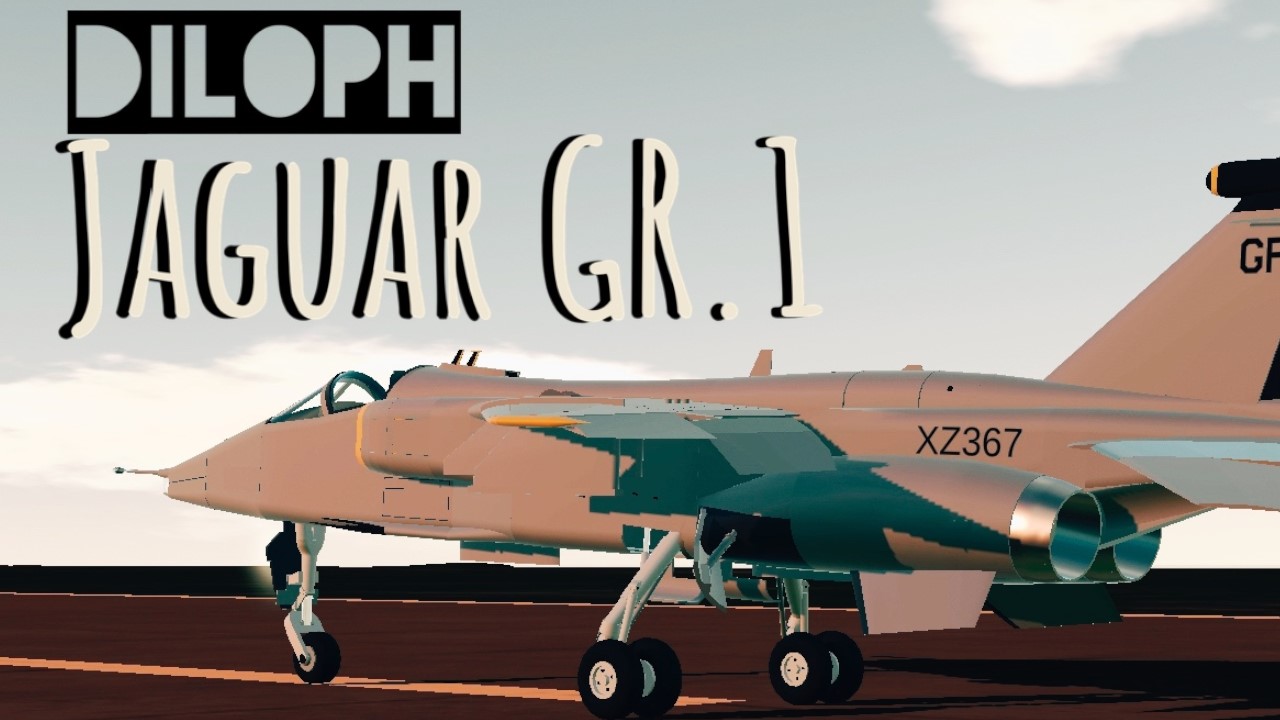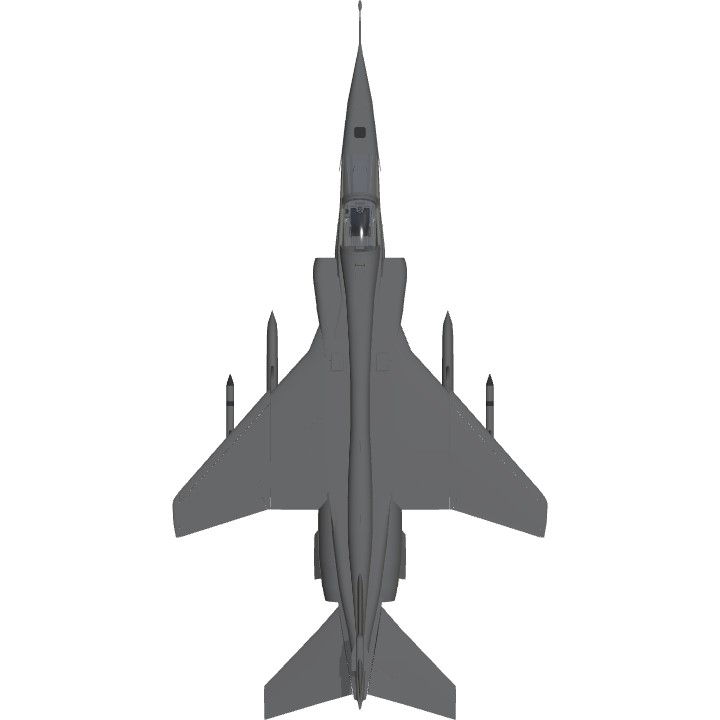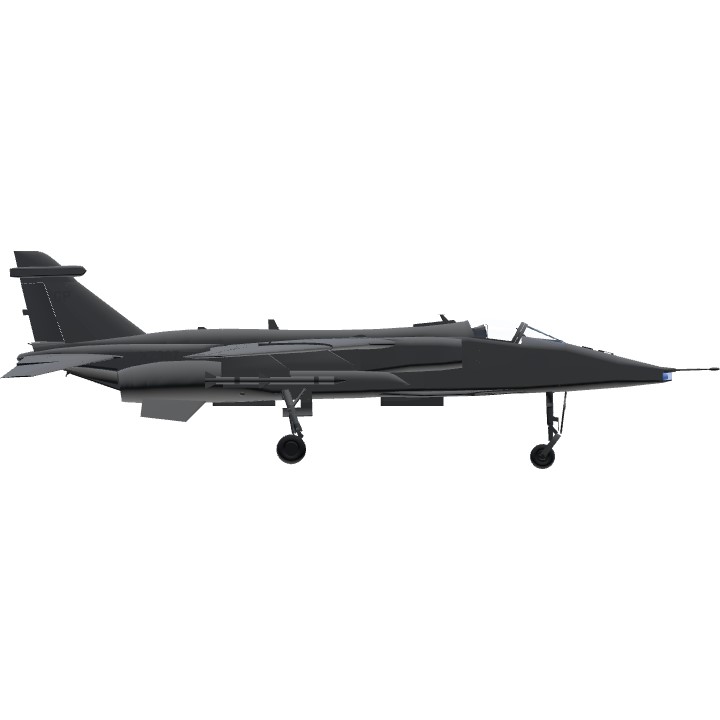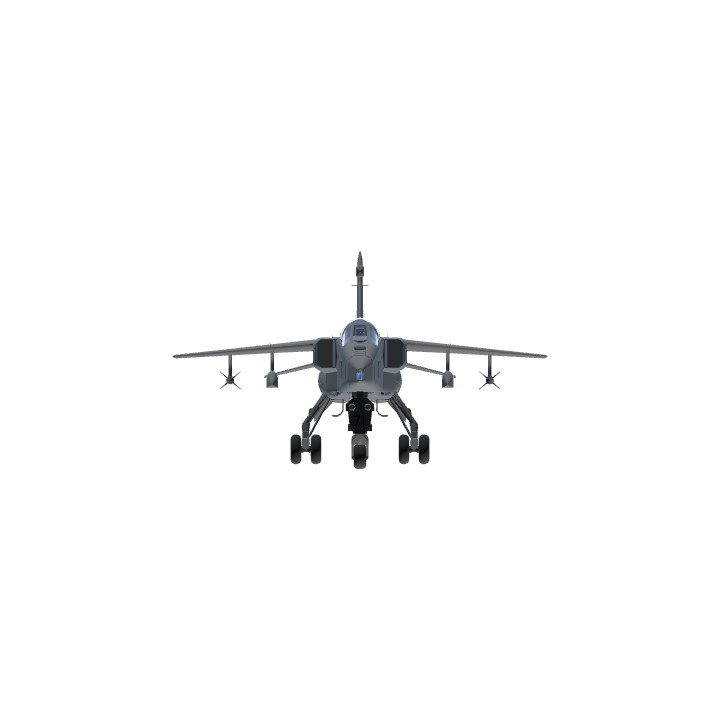Credits to PointlessWhyShouldi-BogdanX-Olli-Hedero!!
Controls!
AG-1 air brake
AG-2 canopy open
AG-3 arrest hook for runway
Wiki
The SEPECAT Jaguar is an Anglo-French jet attack aircraft originally used by the British Royal Air Force and the French Air Force in the close air support and nuclear strike role. It is still in service with the Indian Air Force.
Originally conceived in the 1960s as a jet trainer with a light ground attack capability, the requirement for the aircraft soon changed to include supersonic performance, reconnaissance and tactical nuclear strike roles. A carrier-based variant was also planned for French Navy service, but this was cancelled in favour of the cheaper Dassault Super Étendard. The aircraft were manufactured by SEPECAT (Société Européenne de Production de l'avion Ecole de Combat et d'Appui Tactique), a joint venture between Breguet and the British Aircraft Corporation, one of the first major joint Anglo-French military aircraft programmes.
The Jaguar was exported to India, Oman, Ecuador and Nigeria. The aircraft was used in numerous conflicts and military operations in Mauritania, Chad, Iraq, Bosnia, and Pakistan, as well as providing a ready nuclear delivery platform for the United Kingdom, France, and India throughout the latter half of the Cold War and beyond. In the Gulf War, the Jaguar was praised for its reliability and was a valuable coalition resource. The aircraft served with the French Air Force as the main strike/attack aircraft until 1 July 2005, and with the Royal Air Force until the end of April 2007. It was replaced by the Panavia Tornado and the Eurofighter Typhoon in the RAF and the Dassault Rafale in the French Air Force.
Background
The Jaguar programme began in the early 1960s, in response to a British requirement (Air Staff Target 362) for an advanced supersonic jet trainer to replace the Folland Gnat T1 and Hawker Hunter T7, and a French requirement (ECAT or École de Combat et d'Appui Tactique, "Tactical Combat Support Trainer") for a cheap, subsonic dual role trainer and light attack aircraft to replace the Fouga Magister, Lockheed T-33 and Dassault Mystère IV.[1][2] In both countries several companies tendered designs: BAC, Hunting, Hawker Siddeley and Folland in Britain; Breguet, Potez, Sud-Aviation, Nord, and Dassault from France.[3] A Memorandum of Understanding was signed in May 1965 for the two countries to develop two aircraft, a trainer based on the ECAT, and the larger AFVG (Anglo-French Variable Geometry).[3]
Cross-channel negotiations led to the formation of SEPECAT (Société Européenne de Production de l'Avion d'École de Combat et d'Appui Tactique – the "European company for the production of a combat trainer and tactical support aircraft"[4]) in 1966 as a joint venture between Breguet[N 1] and the British Aircraft Corporation to produce the airframe. Though based in part on the Breguet Br.121, using the same basic configuration and an innovative French-designed landing gear, the Jaguar was built incorporating major elements of design from BAC, notably the wing and high lift devices.[5
Production of components would be split between Breguet and BAC, and the aircraft themselves would be assembled on two production lines; one in the UK and one in France,[6] To avoid any duplication of work, each aircraft component had only one source.[7] The British light strike/tactical support versions were the most demanding design, requiring supersonic performance, superior avionics, a cutting edge nav/attack system of more accuracy and complexity than the French version, moving map display, laser range-finder and marked-target seeker (LRMTS). As a result, the initial Br.121 design needed a thinner wing, redesigned fuselage, a higher rear cockpit, and after-burning engines. While putting on smiling faces for the public, maintaining the illusion of a shared design, the British design departed from the French sub-sonic Breguet 121 to such a degree that it was effectively a new design.[8]
A separate partnership was formed between Rolls-Royce and Turbomeca to develop the Adour afterburning turbofan engine.[9][10] The Br.121 was proposed with Turbomeca's Tourmalet engine for ECAT but Breguet preferred the RR RB.172 and their joint venture would use elements of both. The new engine, which would be used for the AFVG as well, would be built in Derby and Tarnos.[11]
Previous collaborative efforts between Britain and France had been complicated – the AFVG programme ended in cancellation, and controversy surrounded the development of the supersonic airliner Concorde.[12] Whilst the technical collaboration between BAC and Breguet went well,[13] when Dassault took over Breguet in 1971 it encouraged acceptance of its own designs, such as the Super Étendard naval attack aircraft and the Mirage F1, for which it would receive more profit, over the Anglo-French Jaguar.[12][14]
The initial plan was for Britain to buy 150 Jaguar "B" trainers, with its strike requirements being met by the advanced BAC-Dassault AFVG aircraft, with France to buy 75 "E" trainers (école) and 75 "A" single-seat strike attack aircraft (appui). Dassault favoured its own Mirage G aircraft above the collaborative AFVG, and in June 1967, France cancelled the AFVG on cost grounds.[15] This left a gap in the RAF's planned strike capabilities for the 1970s;[15] at the same time as France's cancellation of the AFVG, Germany was expressing a serious interest in the Jaguar,[16] and thus the design became more oriented towards the low-level strike role.[17]
With the cancellation of both the BAC TSR-2 tactical strike aircraft and Hawker Siddeley P.1154 supersonic V/STOL fighter, the RAF were looking increasingly hard at their future light strike needs and realizing that they now needed more than just advanced trainers with some secondary counter insurgency capability. At this point, the RAF's proposed strike fleet was to be the American General Dynamics F-111s plus the AFVG for lighter strike purposes. There was concern that both F-111 and AFVG were high risk projects and with the French already planning on a strike role for the Jaguar, there was an opportunity to introduce a credible backup plan for the RAF's future strike needs – the Jaguar. As a result, by October 1970, the RAF's requirements had changed to 165 single-seat strike aircraft and 35 trainers.[13]
The Jaguar was to replace the McDonnell Douglas Phantom FGR2 in the close air support, tactical reconnaissance and tactical strike roles, freeing the Phantom to be used for air defence.[18] Both the French and British trainer requirements had developed significantly, and were eventually fulfilled instead by the Alpha Jet and Hawker Siddeley Hawk respectively.[19] The French, meanwhile, had chosen the Jaguar to replace the Aeronavale's Dassault Étendard IV, and increased their order to include an initial 40 of a carrier-capable maritime version of the Jaguar, the Jaguar M.[20] From these apparently disparate aims would come a single and entirely different aircraft: relatively high-tech, supersonic, and optimised for ground-attack in a high-threat environment.[21]
Prototypes
The first of eight prototypes flew on 8 September 1968, a two-seat design fitted with the first production model Adour engine.[22][23] This aircraft went supersonic on its third flight but was lost on landing on 26 March 1970 following an engine fire.[24] The second prototype flew in February 1969; a total of three prototypes flew at the Paris Air Show that year. The first French "A" prototype flew in March 1969. In October a British "S" conducted its first flight.[7]
A Jaguar M prototype flew in November 1969. This had a strengthened airframe, an arrestor hook and different undercarriage: twin nosewheel and single mainwheels. After testing in France it went to RAE at Thurleigh for carrier landing trials from their land based catapult, after which, in July 1970, it underwent a series of shipboard trials from the French carrier Clemenceau. From these trials there were doubts about the throttle response in case of an aborted landing. The shipboard testing also revealed problems with the aircraft's handling when flying on one engine, although planned engine improvements were to have rectified these problems.[14] The "M" was considered a suitable replacement for the Etendard IV but the Aeronavale would only be able to afford 60 instead of 100 aircraft.[25]
In 1971, Dassault proposed the Super Étendard, claiming that it was a simpler and cheaper development of the existing Étendard IV, and in 1973, the French Navy ordered it instead of the Jaguar. However, rising costs meant that only 71 of the planned 100 Super Étendards were purchased.[14] The M was cancelled by the French government in 1973.[26]
Design
The Jaguar is an orthodox single-seat, swept-wing, twin-engine monoplane design, with tall tricycle-type retractable landing gear.[5] In its original configuration, it had a maximum take-off weight in the 15 tonne class;[27] with a combat radius on internal fuel of 850 km (530 mi), giving the Jaguar a greater operational range than competitor aircraft such as the Mikoyan MiG-27.[28] The aircraft had hardpoints fitted for an external weapons load of up to 10,000 lb (4,500 kg).[27] Typical weapons fitted included the MATRA LR.F2 rocket pod, BAP 100-mm bombs, MATRA AS37 anti-radar missiles, AIM-9 Sidewinder missiles, and Rockeye cluster bombs.[29][30][31] The RAF's Jaguars gained several new weapons during the Gulf War, including CRV7 high-velocity rockets and American CBU-87 cluster bombs.[32] Finally, the Jaguar was equipped with either a pair of French DEFA cannons,[33] or British ADEN cannons.[34]
The Jaguar International had the unusual option of overwing pylons, used for short-range air-to-air missiles, such as the Matra R550 Magic or the Sidewinder. This option freed up the under-wing pylons for other weapons and stores. RAF Jaguars gained overwing pylons in the buildup to Operation Granby in 1990,[35] but French Jaguars were not modified.[36]
Pictures!











Diloph
-Bigchunguss
Specifications
General Characteristics
- Successors 3 airplane(s) +126 bonus
- Created On iOS
- Wingspan 27.0ft (8.2m)
- Length 51.8ft (15.8m)
- Height 15.7ft (4.8m)
- Empty Weight 14,449lbs (6,553kg)
- Loaded Weight 19,847lbs (9,002kg)
Performance
- Power/Weight Ratio 5.265
- Wing Loading 48.0lbs/ft2 (234.5kg/m2)
- Wing Area 413.2ft2 (38.4m2)
- Drag Points 1643
Parts
- Number of Parts 722
- Control Surfaces 3
- Performance Cost 3,258





@UmbrellaCorporation depends what it is
I heard of that before, but it’s due to a G pulling simulation but it screwed up@ilikeaircraft
good build but the camera is loose inside the canapy
OLLIE* not OLLI
yep i just got beheaded too
Oh damn @WhyBreadSoFattning
@WhyBreadSoFattning
It has split at trailing edge (it high at the root and drop down at the tip) which I haven't seen before or at least unaware of.
What’s wrong with their design?@GuyFolk
Why horizontal stabilizers shaped like that.
Is there any benefit from that design?
I'm just curious about the design.
No the pilot@RC1138Boss
A suspension thing? Does the gear collapse in?@WhyBreadSoFattning
Well again, I take a new part from the section and end up not copying cus I was focused on building. And I am super clueless as in I do things and don’t think about what I’m doing, for instance, I put the recyclables in the non recycables and don’t remember what I was thinking while doing it so I forgot to disable drag @DeezDucks
@WhyBreadSoFattning honestly me neither, I just turn it off with my first part and try to keep using that/ copying it.
@RC1138Boss uh thats a suspension deal, i didnt know how to ffix that one
@DeezDucks yeah, i can never build and remember to take off drag with every part, it just doesnt work with my heead to remeber but ty
Heads up, when pulling high g manevoivpurs the camera snaps it’s neck.
@WhyBreadSoFattning Yeah it's a personal taste kind of thing, so don't worry about it. You can always repaint it though, an excuse to re-release it :)
Oh... your issue for not finding any parts to take drag off is cause you have literally every part's "calculate drag" set to true. You get about the same result with how you did it compared to turning calculate drag off. But it's a lot simpler to tweak drag the second way. Just turn drag on for the nosecone/leading edges of the wings and whatnot so it's less of a headache. plus when you only turn down dragscale to 0 or something, the game still does the drag calculation for it, so the second way also reduces lag somewhat. Next time if you want, try that trick with the engines. The CF-105 I was working on has about the same drag count as this, but has a more realistic takeoff roll.
@DeezDucks well i oculd not find more parts to take drag off, or i would
Just lower the drag then you can in turn lower the engine thrust, currently the acceleration is insane, it takes off in a fraction of the time and irl 940m distance the real one needs. A potentially helpful tip I have is to lower the engine powermultipler while increasing the engines max value. I did that on my CF-105.
I hated the side winder on top, but daNgit I wish I did@Falkenwut
Listen, it needed good acceleration and ok speed, but I couldn’t make it faster without insane acceleration, it’s good enough right? @DeezDucks
Damn this is cool
Amazing build! The Best build on the site I think... If you place sidewinders on top of the wing, it would have cemented the place as THE BEST EVARR
@WhyBreadSoFattning I was not aware that 400kmh was that fast for a mach capable jet lol.